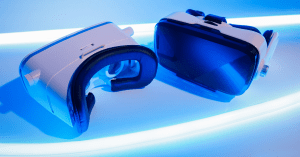There are a few different types of VR sickness (also sometimes called cybersickness) that can occur when a person spends time in a virtual environment. Because the symptoms of virtual reality sickness tend to be similar to motion sickness, people sometimes refer to it generically as VR motion sickness, but there can be a few different causes that aren’t necessarily caused by motion.

VR motion sickness due to lack of physical motion
When you put on a virtual reality headset and start to move around, your brain can get confused. Your eyes tell your brain that you should be moving, but your body isn’t really moving. This mismatch between what your eyes see and what your body feels can cause VR motion sickness.
The body’s internal balance system called the vestibular system is what tells your brain how your body is moving in space. The inner ears also make up important parts of this system. When you’re in a virtual environment, your vestibular system can get confused which can lead to the symptoms of motion sickness.
VR motion sickness is different from regular motion sickness, which is caused by actual movement. With VR motion sickness, it’s the virtual movement that tricks your brain and causes the symptoms. However, people that are more sensitive to motion sickness in the physical world are more likely to experience virtual reality sickness.
Motion sickness in VR due to latency or refresh rate
Another issue that can cause VR motion sickness is latency, which is the delay between when you move your head and when that movement is reflected in the virtual world. If there’s too much of a delay, the sensory conflict can cause VR sickness.
The refresh rate is the number of times per second that the image on the screen is refreshed. A low refresh rate can also cause VR sickness if the image isn’t refreshed fast enough. This can cause a laggy or choppy feeling in the virtual world, which can lead to VR sickness.
Symptoms of VR sickness
The most common symptoms of VR sickness are very similar to motion sickness and can include:
• Nausea
• Vomiting
• Cold sweats
• Increased heart rate
• Disorientation
• Dizziness
• Headaches
Tips to Prevent VR Motion Sickness
There are a few things you can do to try to prevent VR induced motion sickness, including:
• Taking breaks often
• Playing simpler VR games
• Choosing a VR game that can be played from a seated instead of standing position
• Adjusting the focus or IPD (inter-pupillary distance) settings in your VR headset
• Choose the right headset. A high-quality VR headset can help VR feel comfortable.
Studies have shown that the likelihood of VR sickness increases the longer you remain immersed in the virtual environment, so taking breaks often is important to reduce motion sickness.
Frequent breaks during VR experiences can also reduce eye strain and other symptoms such as repetitive motion stress that can occur when you play games in virtual reality for
If you start to feel dizzy or sick while wearing a VR headset, it’s best to take it off right away. Once you take off the headset, the symptoms should start to go away and you should be back to normal within several hours. You may also want to try getting some fresh air, as cool air can help your body recover especially if a game makes you hot and you find yourself sweating.
Developing Your ‘VR legs’
The term “VR legs” builds on the idea of “sea legs” from the boating world. The body can take time to adapt to the motion of the waves when on a boat. Once you’ve adapted and no longer feel disoriented or sea sick it is said that you have your “sea legs” and are able to move around the boat more naturally.
In the same way, you can build up resistance to the effects of cybersickness. The best way to approach this is to play games in smaller doses at first, gradually increasing the length of your VR work or play sessions. This can help your brain adapt to the virtual movement and reduce the chances of you feeling sick.
You may also want to focus on seated games or experiences at first, as standing up in VR can be more likely to cause discomfort. Your body is able to relax more when you are in a sitting position and there is less risk of falling. Once you get used to moving around in virtual reality, you can try standing up and playing active VR games.
VR sickness due to vergence-accommodation conflict (VAC)
Vergence-accommodation-conflict or VAC is one of the main causes of VR sickness. It happens when your eyes are trying to focus on something close to you, but your brain is processing information that’s far away.
For example, when you’re looking at a screen, your eyes naturally converge (come together) and focus on what you’re looking at. But in VR, your eyes might be converging on one thing while your brain is processing information about something else that’s further away. This conflict can cause symptoms of VR sickness.
What is cybersickness (a.k.a. simulation sickness)
Cybersickness, also known as simulation sickness, is a more general term that refers to the feeling of sickness that you can get from using certain types of technology, like VR headsets. The symptoms are similar to those of regular motion sickness, like nausea and vomiting.
However, cybersickness can also be different from VR motion sickness because it can happen even if you’re not actually moving. For example, you might start to feel sick if you’re watching a moving video on a screen that’s very close to your face. This is typically caused by some of the factors mentioned above such as VAC, refresh rate, or other challenges with maintaining focus.
Who is most susceptible to virtual reality sickness
Unfortunately, it appears there may be some uncontrollable factors that may make certain people more susceptible to being motion sick. Each individual is different, but some general trends are worth being aware of. The science is still emerging here so it will be interesting to see what scientists learn as they get to the bottom of what causes these trends.
Age
The incidence of motion sickness, in general, is highest among children age 12 and under, and the same goes for VR sickness. Susceptibility then decreases significantly until age 21 or so. However, some studies have shown that adults over the age of 50 may be more susceptible compared to young adults.
Gender
There seem to be conflicting studies on this topic, but gender differences may contribute to the likelihood of VR sickness. Several studies seem to show that women have a higher susceptibility to VR sickness compared to men, but the root cause for this is not yet clear and some recent research disagrees as to whether sex is truly a significant factor. Some speculate that it relates to hormonal differences or differences in depth cue recognition between genders, but more studies are needed.
Postural stability and other ill health
Some data suggest that people who suffer from existing postural instability are more likely to experience motion sickness in VR. The same has been observed for people who are generally not in good health whether due to being already sick or suffering from chronic conditions that weaken the body. If you feel sick, listen closely to your body and pay extra attention to how your body adjusts to the game world. It’s probably best to avoid VR altogether if you already feel ill.
For people who experience nausea and other forms of negative effects from VR motion sickness, it’s obviously not a fun experience. Because this could be a major barrier to the adoption of VR platforms, you can bet that VR headset manufacturers and VR gaming developers are working hard to understand how to avoid these issues moving forward so it’s likely we’ll see significant improvements over the next few years.
Technical factors impacting virtual reality sickness
If you’re a VR developer or generally interested to learn more about the technical factors impacting virtual reality sickness, this wikipedia article is a great place to start. You may want to dig deeper into the following concepts to develop your understanding of the known related technical factors that can impact simulation sickness:
- Mismatched motion
- Motion parallax
- Field of view
- Viewing angle
- Static frame of reference
- Immersive Index






